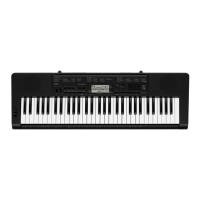
Do you have a question about the Casio CTK-2080 and is the answer not in the manual?
| Number of Keys | 61 |
|---|---|
| Polyphony | 48 |
| Display | LCD |
| Auto Accompaniment | Yes |
| Metronome | Yes |
| Touch Response | No |
| Tones | 400 |
| Built-in Songs | 110 |
| Power Supply | AC adapter or 6 AA-size batteries |
| Sound Source | AHL |
| Digital Effects | 10 types |
| Lesson Function | Yes |
| Speakers | Yes |
| Audio Input | Yes (Audio In) |
Identifies and explains the main buttons and controls on the keyboard.
Detailed explanation of each numbered button and its function.
How to use number buttons and the Function button for settings.
Information on using AC adaptor or batteries for power.
How to turn on the keyboard and adjust volume.
How to connect and use headphones for private practice.
How to adjust touch sensitivity for volume control.
How to use voice pads and the metronome for practice.
Adjusting the speed of the metronome.
How to choose different instrument tones.
How to add and adjust reverb and pedal effects.
Adjusting pitch via transpose, tuning, and pitch bend wheel.
Steps for connecting devices and performing sound sampling.
How to play demo songs and select specific songs.
Controls for pausing and skipping during song playback.
Adjusting repeat measures, tempo, and song volume.
Understanding song phrases and the Step Up Lesson process.
Choosing songs/phrases and understanding lesson messages.
Disabling phrase division and other lesson settings.
A visual guide to the Auto Step Up Lesson sequence.
Steps to start and play the Music Challenge game.
What happens when the game ends and how scores are evaluated.
How to play only the rhythm track for practice.
Playing all parts and selecting chord input methods.
How to play chords using Fingered and CASIO CHORD modes.
Configuring synchro start, adjusting volume, and using presets.
Guide to connecting the keyboard to a computer via USB.
Configuring keyboard and navigate channels for MIDI communication.
Managing local control and sending accompaniment data to computer.
Connecting keyboard audio out and external audio in.
Solutions for common problems and issues encountered with the keyboard.
Detailed technical specifications and features of the digital keyboard.
Important guidelines for safe and proper product use and operation.
Guidelines for placement, cleaning, and accessory usage.
A comprehensive list of all built-in songs.
Visual guide for fingering various chords on the keyboard.
Technical chart detailing MIDI communication protocols and functions.
